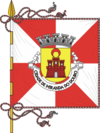Miranda do Douro
| Miranda do Douro | |||
|---|---|---|---|
| Municipality | |||

Cathedral
|
|||
|
|||
 |
|||
| Coordinates: 41°29′39″N 6°16′27″W / 41.49417°N 6.27417°WCoordinates: 41°29′39″N 6°16′27″W / 41.49417°N 6.27417°W | |||
| Country |
|
||
| Region | Norte | ||
| Subregion | Alto Trás-os-Montes | ||
| Intermunic. comm. | Terras de Trás-os-Montes | ||
| District | Bragança | ||
| Parishes | 13 | ||
| Government | |||
| • President | Artur Manuel Rodrigues Nunes (PS) | ||
| Area | |||
| • Total | 487.18 km2 (188.10 sq mi) | ||
| Elevation | 752 m (2,467 ft) | ||
| Population (2011) | |||
| • Total | 7,482 | ||
| • Density | 15/km2 (40/sq mi) | ||
| Time zone | WET/WEST (UTC+0/+1) | ||
| Postal code | 5210 | ||
| Area code | 273 | ||
| Patron | Santa Maria Maior | ||
| Website | http://www.cm-mdouro.pt/ | ||
Miranda do Douro (Portuguese: [miˈɾɐ̃dɐ ðu ˈðowɾu]) or Miranda de l Douro (Mirandese: [miˈɾãdɐ ðɨɫ ˈðawɾu]) is a town and a municipality in the district of Bragança, northeastern Portugal. The population in 2011 was 7,482, in an area of 487.18 km². The town proper had a population of 1,960 in 2001. Referred to as the "Cidade Museu" of the Trás-os-Montes region, it is located 86 kilometres from Bragança, preserving many of its medieval and Renaissance-era traditions and architecture. It has a language of its own, Mirandese, which enjoys official status in Portugal, in addition to cultural and historical discontinuity with the rest of the Portuguese state. The town is located on the border with Spain, with the Douro River separating the two countries. The nearest town in Spain is Zamora.
The present mayor is Manuel Rodrigo Martins (Social Democrat) and the president of the Municipal Assembly is Domingos Duarte Lima (Social Democrat). The municipal holiday is on July 10.
The origin of Miranda do Douro as a populated place is still discussed by historians, but archeologist discoveries give evidence that inhabitants have been living there during the Bronze Age. Around AD 716, the Moors defeated local Visigothic tribes, and occupied some of the lands, calling the area Mir-Hândul.
By the late 11th century, Castile coveted the region as a stepping-stone to Portugal. The settlement of the village of Miranda developed through the initiative of King Denis, in an area that lay between the lateral slopes of the Douro and Fresno Rivers. It was in Miranda that the Treaty of Alcanices was signed between Denis and Ferdinand IV of Castile, setting the border between the two kingdoms. Miranda was founded on 18 December 1286, and immediately elevated to the status of vila (English: town), with one of its prerequisites declaring that the administrative division would be a Crown fief. From that period forward, Miranda became progressively one of the most important towns that skirted the Trás-os-Montes region.
...
Wikipedia


